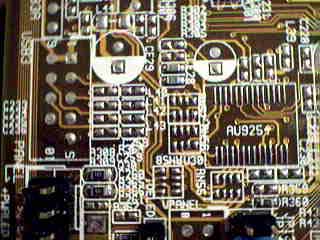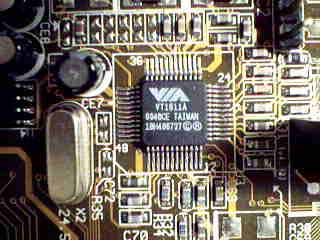ASUS A7V133 Socket-A KT133A ATX
by Mike Andrawes on February 12, 2001 1:45 AM EST- Posted in
- Motherboards
The Bare Essentials
The VIA 8363A North Bridge sits right between the CPU socket and the AGP Pro slot. It is the core of the KT133A chipset that provides all the major features of the board including official support for 100 / 133MHz FSB and memory buses, as well as AGP 4X support. Just like most of the recent ASUS motherboards, the A7V133 is equipped with an AGP Pro slot. Save for a few very high end graphics cards, the extra power carrying cabilities of AGP Pro are rarely required. The AGP Pro slot is a universal slot, which means it is not keyed specifically for 1.5V or 3.3V cards, so you can install almost any current AGP card in the slot.
The 8363A North Bridge officially supports the 133MHz DDR FSB (266MHz effective), naturally offering support for the new 133MHz FSB Athlons as well. In the past, even with 1GHz Athlons, you were limited to a FSB speed of 100MHz DDR and a multiplier of 10. Now the KT133A chipset allows you to have a FSB speed of 133MHz and possibly higher, so that with the same 1GHz chip, you can lower the multiplier to 7.5, and effectively boost the overall performance while remaining at the same clock speed. This is technically a form of overclocking, but is probably the safest form possible.
Most of the recent AMD Socket-A motherboards have included the hardware mechanism for changing the multiplier ratio settings of AMD processors, so this can be done easily. There is some effort required on your part to prepare your CPUs for overclocking, however we have diagrammed exactly what is necessary in our Athlon Overclocking Guide. Make sure you read the guide in order to fully unleash the power of your Socket-A processor.
Just like most other KT133A solutions, the A7V133 features a total of three DIMM slots, supporting up to 1.5GB SDRAM. The memory controller in the 8363A North Bridge allows you to run your memory at either 100MHz or 133MHz, depending on your FSB choice. When running a 100MHz FSB, you have the option to choose 100MHz or 133MHz memory operation. However, at 133MHz memory speed is always synchronous. Officially the KT133A chipset only supports FSB:memory ratios of 100:100, 100:133, or 133:133.
The newer VIA 686B South Bridge has replaced the good old VIA 686A South Bridge that was used on most KT133 boards. The advantage of the 686B over 686A is that it supports Ultra ATA 100, whereas the 686A only supports Ultra ATA 66. The Ultra ATA 100 controller provides two IDE channels that support up to 4 IDE devices (two per channel).
Two traditional USB ports are mounted at the back of the motherboard together with the serial / parallel ports, and there are connectors ready for a third and fourth USB port at the left side of the board. Luckily enough, when you purchase the A7V133 you will get the necessary USB bracket to take advantage of the second USB controller. Unfortunately, unlike the A7V, ASUS does not feature the of the on-board Alcor Micro AU9254 USB Hub that offered another three USB connectors. Therefore the A7V133 “only” features four USB ports, as opposed to the seven of the A7V. ASUS still retains the silk screen on the A7V133 for the Alcor Micro USB Hub, so if there is a need ASUS can always add the chip back or even make it an optional feature.

The silk screen for the Alcor Micro chip and the USB connector.
The 5/1/0/1 (PCI/AGP/ISA/AMR) expansion slot design, although not ideal, should be more than enough for most users. For those who still want to keep some of their ISA devices, the A7V133 is just not going to be the right choice. Although the overclocking market is growing rapidly, ASUS is still one of the largest supporters in the OEM market, which is still the source of the majority of their sales. Therefore, keeping the AMR slot helps OEMs provide a low cost modem solution for end users.
This time around, ASUS decided to add in onboard audio, using the VIA VT1611A for AC’97 audio CODEC. On the A7V, this was an option that was usually only found in OEM versions of the board. Once again, AC’97 audio is capable of providing basic sound for some users, but for anything more, you really should go with a hardware-based PCI sound card. ASUS also has a version of the A7V133 without on-board audio, which should bring down the price of the board slightly.

VIA VT1611A CODEC










2 Comments
View All Comments
Ammoboard - Thursday, August 8, 2019 - link
Buy Blazer Brass 9mm Handgun Ammo in affordable price at Ammo Board. We offer you the best price deals on top branded ammunition. Ammo Board is online ammunition shop to fulfill your bulk ammo needs. We pride ourselves on offering the best variety of ammunition products with free shipping, careful packaging and smooth hassle-free transactions. Get special deals on 9mm Ammo, 380 ammo, 17 hmr ammo and more.https://www.ammoboard.com/handgun-ammo/9mm